Largely solitary, nocturnal, venomous and pint-sized, slow lorises are strong contenders for the primates that least resemble humans. Which may be why they are among the least studied, least protected and most poorly understood primates, according to Anna Nekaris, professor of primate conservation and biological anthropology at Oxford Brookes University.
“Out of over 600 primate species, we have five great apes, and everybody wants to study them,” she says.
While the plight of orangutans and gorillas has been well publicised, all nine species of slow loris, spread across southern and south-east Asia, are quietly decreasing in number and slipping down the IUCN red list. Philippine, Kayan and Bornean slow lorises are classed as vulnerable; Pygmy, Bengal, Sumatran and Sunda slow lorises are endangered; while Bangkas and Javans are critically endangered.
Nekaris (pictured) has been devoted to lorises (there are slender lorises in India and Sri Lanka, too) since 1994, and is on a mission to help them through her research and conservation organisation Little Fireface Project. Spearheading these efforts is a field programme in Java, Indonesia, where she is directing the first long-term study of lorises in the wild.
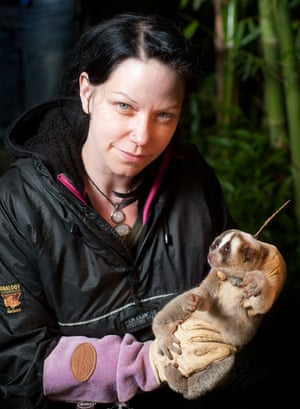
“It took about four years before the [local] farmers started taking us seriously,” says Nekaris. Key was teaching children about lorises through a nature club and the Slow Loris Forest Protector programme, making hunting and littering bans matters of local pride, and working with farmers on growing methods and infrastructure to benefit both them and the displaced Javan slow loris.
Nekaris says the main threat to the animals has been habitat loss. Java is the most populous island on the planet, with about 130 million people on an island the size of New York state. Little more than 7% of its forests remain. “Somebody’s gone and taken all the tropical hardwoods and sold them for their wood … There are virtually no lowland rainforests left on Java,” says Nekaris. “It’s a miracle there are any [lorises] at all.”
The protected national parks are at too high an altitude for naturally forest-dwelling slow lorises. Their home ranges can be 25 hectares (61 acres), but lorises creep rather than leap, and rely on vines in the canopy to get around.
“The ones we’re studying,” says Nekaris, “are living in a human-dominated landscape, in hedgerows around tea, coffee and tomato fields.” While this has made it easier to attach radio collars to study them, says Nekaris, in the absence of joined-up forest the animals have to cross about 200 metres of ground to reach the next clump of trees. “There are predators such as leopards and dogs, and there are humans trying to catch them,” she says.
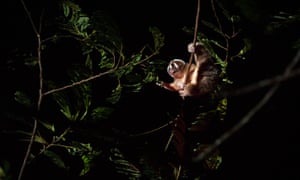
-
A Javan slow loris seen foraging in the canopy
Slow lorises are part of the illegal wildlife trade in Asia. Once they have been captured, their teeth are clipped to ensure they cannot bite and they are sold as cute, docile pets, or used as props for holiday photos in tourist areas. With those vast eyes in teardrop markings, they look like cuddly toys and get a lot of likes on social media.
In reality, they grow bloated from a poor diet and their eyes fail from light exposure. But unlike the great apes, with their relatable facial expressions, a slow loris’s misery may be hard to spot. When tickled, they shoot their arms up as if enjoying the experience but it is actually a sign of distress. Their cry is ultrasonic, which means it is at too high a frequency for humans to hear.
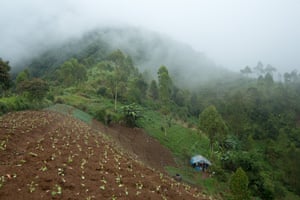
-
The main threat to the slow loris is habitat loss. Java is the most populous island in the world
As well as their fatal cuteness, slow lorises are believed by some to be the animal that can cure a hundred diseases and are sought after for use in traditional medicines.
Trial and error
In December 2019, Nekaris published the results of a successful study into whether building a network of bridges could make up for the lack of safe passage in tree canopies and improve the lot of the Javan slow loris. It was a conclusion reached by trial and error.
At first, Nekaris had installed some ladder-like bridges between trees that were used elsewhere in monkey conservation, but the lorises didn’t take to them. Then she realised that the answer might lie with some of the local farmers’ irrigation pipes. Because of the hilly terrain, some of the pipes were suspended high above ground level, and lorises had been seen crossing them. Nekaris hit on the idea of installing more of them, which would benefit the farmers, too. Twelve days after installation, motion-sensor cameras showed the animals starting to creep across the new pipes.
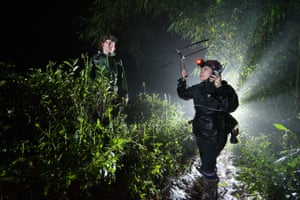

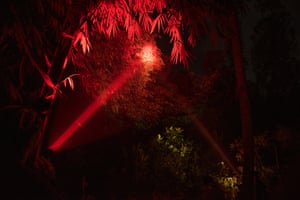
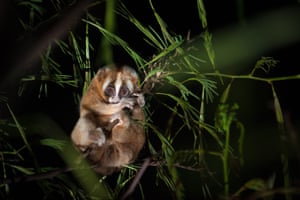
-
When tracking lorises, Nekaris and her team use a red-filtered torch to avoid disturbing the animals. In the image below, a loris is fitted with a tracking device
Nekaris witnessed the animals grow in confidence, she says, “because they’re in the air. They’ve increased their home range sizes, and the areas within the home ranges that they can use.”
With funding from the People’s Trust for Endangered Species in the UK, and Cleveland zoo in the US, there are now more than 20 water-pipe bridges in place. The bridges allow the lorises to reach previously inaccessible feeding trees, where they gouge out gum with their teeth. Nekaris also found the lorises could spend less time travelling, more time feeding and, crucially, get enough rest.
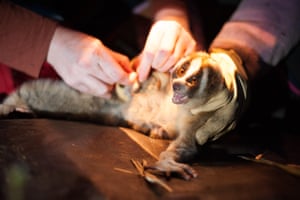
An added benefit of using water pipes is that the farmers have a vested interest in their maintenance. “The longest bridge is about 400 metres,” says Nekaris. “Some of them have to go over multiple farmers’ lands so you have to negotiate with them to work together.”
Getting the piping to the farms has become, she says, “a community event because people have to bring it up the mountain on motorbike. You have to find the water source to connect it to and then get it to travel where it needs to go. And then the interesting thing was, of course, other farmers started saying, ‘Well, I don’t have slow lorises on my land and I didn’t get a bridge. It’s not fair.’ So then as a contingency, we had to give other people bridges as well, even if they didn’t have lorises.”
Nekaris also introduced the idea of shade-grown coffee to the village, growing coffee in its natural habitat of the understory, pollinated by insects, in sustainably fertile soil. Last year, says Nekaris, “we went with the farming community to a herbarium and picked trees that were useful for the animals but also for fixing nitrogen in the soil and preventing soil erosion and landslides.” They included some “cash” trees, too, “which after 10 years could be cut for timber and replaced”.
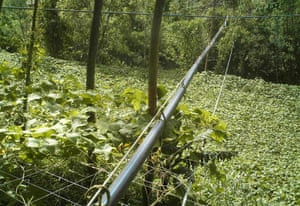
-
Water-pipe bridges allow lorises to reach previously inaccessible feeding trees
There was the extra incentive of certification from the Wildlife Friendly Enterprise Network, which involved meeting criteria such as hunting bans, introducing FairTrade and organic practices and boosting habitat through shade-grown crops.
A local ban on hunting endangered species was agreed in September 2019, says Nekaris, “with all the signs up by October, and that included birds as well”. The villagers agreed to a littering ban, too. “There’s plastic everywhere,” says Nekaris. “And it affects people’s livelihoods all the way down the mountain because it fills the streams that provide their drinking water.”
Interest is growing in a new waste management system, and as this environmental awareness trickles down the mountain, so does the plight of the slow loris. A nearby village is discussing joining the hunting ban. Building bridges for the slow loris, says Nekaris, “has started to build bridges within the community”.
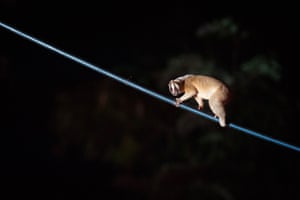
-
An added benefit of using water pipes for slow loris bridges is that farmers have a vested interest in maintaining them
Find more age of extinction coverage here, and follow biodiversity reporters Phoebe Weston and Patrick Greenfield on Twitter for all the latest news and features